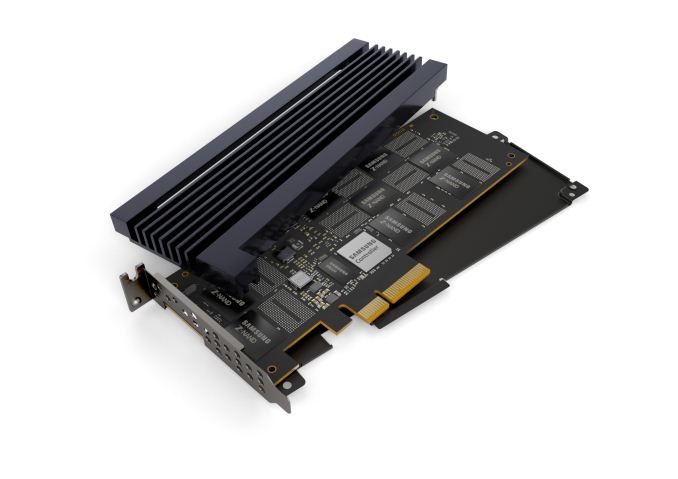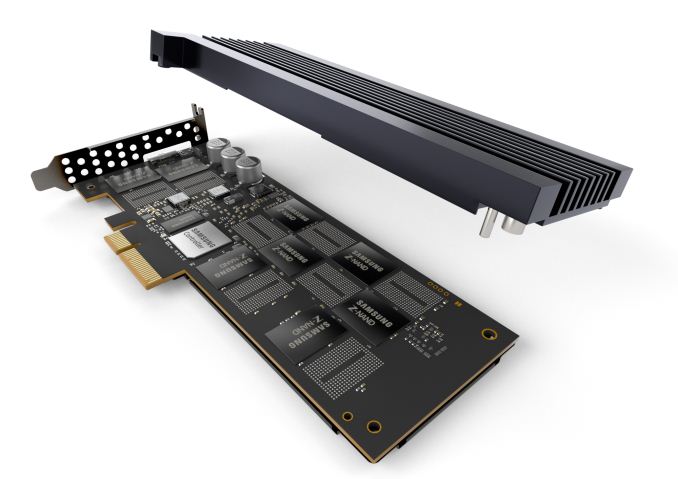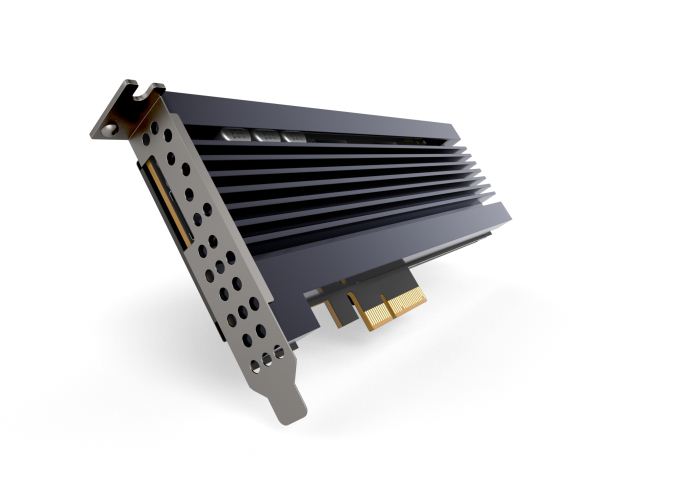Samsung Launches Z-SSD SZ985: Up To 800GB Of Z-NAND
by Billy Tallis on January 29, 2018 9:00 PM EST
Samsung announced today that they are officially launching their first Z-SSD product, the SZ985. The Z-SSD uses Samsung's Z-NAND memory, a high-performance derivative of their 3D NAND flash memory and Samsung's intended competition for Intel's 3D XPoint memory. The SZ985 is a high-performance, high-endurance enterprise NVMe SSD.
Samsung has been talking about Z-NAND and the SZ985 for quite a while, including showing off prototypes at several trade shows and conferences. Their initial announcement in 2016 of Z-NAND memory and Z-SSD drives promised 1TB drives in 2016 to be followed by 2TB and 4TB drives in 2017. Today's launch of 800GB and 240GB models is far behind that initial timeline, but the Z-SSD is finally ready for broad release, almost a year after Intel's Optane products first hit the shelves. Samsung hasn't provided much new information about how the Z-SSD works under the hood, but they have disclosed that the drive includes 1.5GB of LPDDR4 DRAM. This suggests that the Z-SSD either has huge overprovisioning with as much as 1.5TB or Z-NAND memory for the 800GB model, or that the Z-NAND is being managed in a way that requires more than the usual 1GB of DRAM per TB of NAND flash used by most SSDs.
Samsung has not provided full performance specifications for the SZ985, but they have highlighted several key metrics that put the Z-SSD in the top performance tier. The SZ985 can deliver up to 750k random read IOPS, well above the 550k IOPS that Intel's Optane SSD DC P4800X is rated for. Write performance from the SZ985 is much less impressive at only 170k random write IOPS. The random write speed rating on Intel's P4800X is only 9% slower than the random read speed, while the Samsung SZ985 will have a random write speed that is 77% slower than random reads. Samsung has not been able to overcome all of the limitations of flash memory, but they have produced some impressive improvements.
Samsung also makes a few comparisons against more mainstream enterprise SSDs based on 3D TLC NAND flash memory. The memory cell read performance of their Z-NAND is ten times higher than their 3D TLC NAND, leading to 70% higher random read throughput than their PM963 NVMe SSD. Exact read latency isn't specified, but write latency on the SZ985 is quoted as 16 µs.
Despite not having record-setting write performance, the SZ985 is still designed to handle very write-intensive workloads. The endurance rating is 30 drive writes per day for five years, matching Intel's Optane SSD. However, both drives still fall short of the long-gone Micron P320h SLC NAND SSD, in both performance and endurance (though Intel has at least exceeded the random write speed of the P320h). Samsung's most significant accomplishment with the Z-SSS SZ985 is likely that they can offer the performance of planar SLC at much lower cost thanks to their 3D NAND structure.
Samsung will be presenting the Z-SSD SZ985 at the International Solid-State Circuits Conference, February 11-15.
At Flash Memory Summit last year, Samsung announced a second generation of Z-NAND memory. The SZ985 is still a first-generation product, and drives with the second-generation Z-NAND could still be a long way from launching.
Source: Samsung












45 Comments
View All Comments
romrunning - Tuesday, January 30, 2018 - link
@iter:You mention consumer a lot, but the target of this Samsung drive is literally written in the article: "The SZ985 is a high-performance, high-endurance enterprise NVMe SSD." Enterprise is the target here, not consumer.
In regards to Optane in the enterprise, the problem I see is the capacity isn't there yet. It also needs more models in U.2 form factor to aggregate to higher total capacity; AIC limits you to that single slot solution. That's limiting sales to the enterprise more than any fault due to the technology itself. So if Intel makes profit selling the smaller capacity Optane drives to consumers, it's because they are just making good use of their existing product line while they continue to work on the overall capacity.
I can definitely agree that SLC would have been nice to keep around & continue to improve upon. The performance was certainly there. But the mfgs wanted more profit, and the buyers wanted more capacity. So that's why we got MLC/TLC, and sadly, probably even QLC. It does make me wonder where we would be with SLC now, though, if continual improvements were made there.
However, I definitely disagree with your statement that the "reason the industry walked away from slc was that it was too good, even for the enterprise... " Enterprise loads have always needed the most storage performance as possible as storage is almost always the biggest bottleneck for performance. Whether it's OLTP, massive databases, huge virtual hosts - more storage performance is always needed. The consistency & low latency are also benefits of Xpoint, so that's welcome as well.
romrunning - Tuesday, January 30, 2018 - link
Now that I think about it, maybe this Samsung drive is the successor to SLC based upon continual R&D Samsung made even after transitioning to MLC/TLC & 3D NAND.Lolimaster - Tuesday, January 30, 2018 - link
Seems even Samsung forgets about MLC and uses shitty TLC for comparison.Why can't they simply use SLC again? not simulated crap with MLC?
Flunk - Tuesday, January 30, 2018 - link
Because hilariously, that would cost more.iter - Tuesday, January 30, 2018 - link
Well, once invested in the production lines for slc, it will actually be a tad more affordable than mlc per cell, as the cell design is simpler, and it would perform much better for that same reason.The only logical reason for samsung to go for that nonsense is the fact they don't have slc production lines, and it would probably cost more money than they will make on overpriced niche market products.
Reflex - Tuesday, January 30, 2018 - link
People do not buy their storage 'per cell'. SLC has exactly half of the potential capacity as MLC, and a third the potential capacity as TLC in any given implementation. While NAND is not the entire cost of a drive, it is by far the largest driver of cost and as such there is no world where simply 'investing more' in production lines brings its prices even close to MLC or TLC. Virtually every improvement that would apply to SLC also applies to MLC and TLC making it always the most expensive route to go.SLC is not coming back because its gains are marginal for most use cases while its cost is always going to be substantially higher than price/performance dictates is reasonable.
Lolimaster - Tuesday, January 30, 2018 - link
Random Reads are way more important than random writes since the former is basically the operation mode of a drive.Lolimaster - Tuesday, January 30, 2018 - link
And no, this thing can not "offer the performance" of a proper SLC, it can try to bruteforce random workloads but endurance is simply not possible by definition.FunBunny2 - Tuesday, January 30, 2018 - link
"endurance is simply not possible by definition"yes, I suppose, at a fixed node size, but the lure of 3D/Z NAND is that cells are made on much larger node size than current SotA. 40nm (or a bit more), IIRC, so endurance is, mostly (modulo multi-voltage effects, if any) what one might expect historically at that node size(s).
FunBunny2 - Tuesday, January 30, 2018 - link
as to SLC/MLC/TLC: back when the move was from SLC to MLC, the conventional wisdom (even here, IIRC) that the NAND cells were the same. the chip was the same. the difference was in what voltage(s) the controller read/write to the cells.is there some docs on why, today, TLC for example is physically different from SLC???